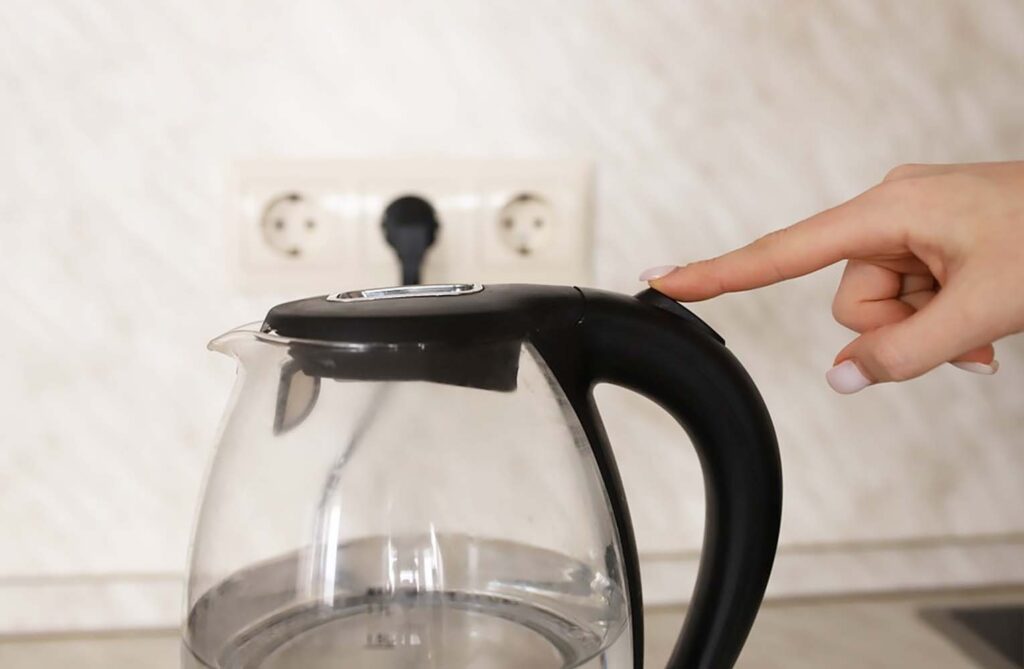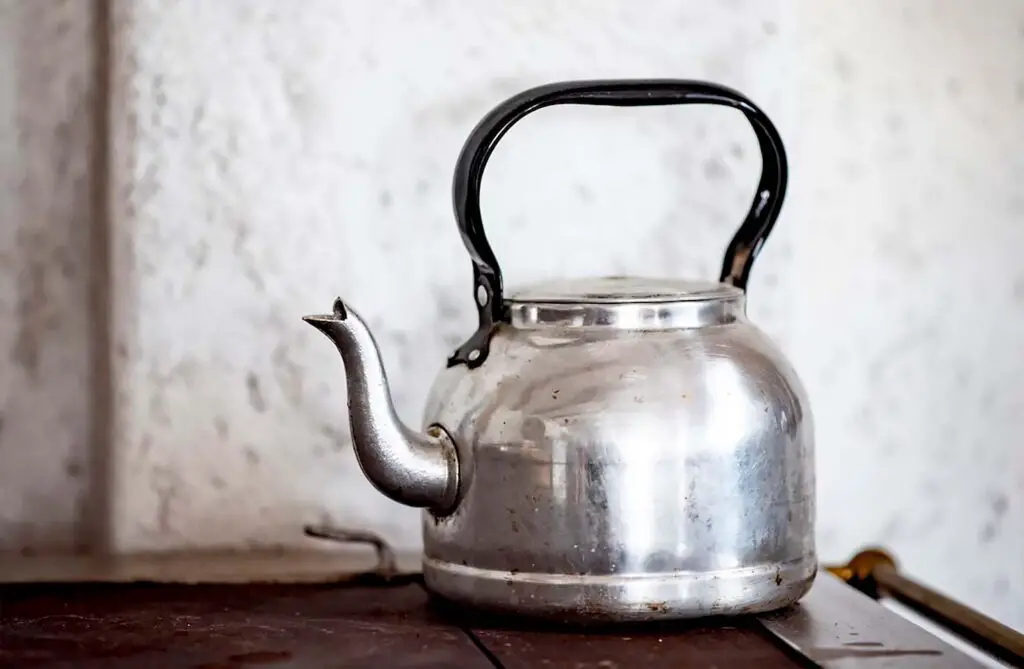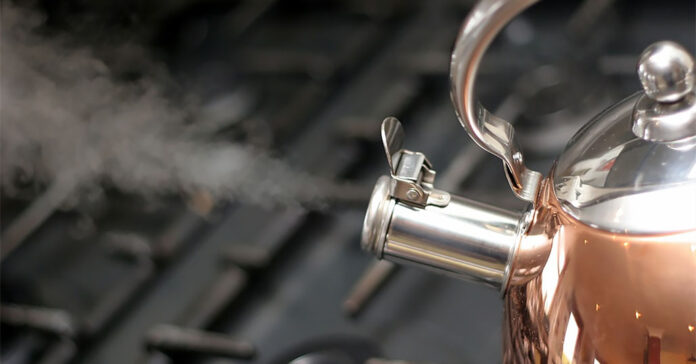One of the questions that we get asked almost every day is: should you place an electric or traditional kettle directly under your kitchen cabinets? While this might seem like a weird question at first, it’s actually a matter of protecting your kitchen furniture! Let’s dive into the topic and figure out how to prevent kitchen cabinet damage with proper kettle placement!
- Can You Put a Kettle Under a Cabinet?
- What’s The Worst That Can Happen?
- Electric vs. Traditional Kettles
- Can You Repair Cabinets Damaged With Steam?
- How Can You Protect Your Cabinets From Steam?
This web portal is supported by its readers, and is a part of the Amazon Services LLC Associates Program and the eBay Partner Network. When you buy using links on our site, we may earn an affiliate commission!
Check out also: 8 Easy Ways To Save Money In Your Kitchen (Must Read!)
Can You Put a Kettle Under a Cabinet?
The source of this question stems from the most common type of damage that your kitchen cabinets can face – and that is water damage.
While this might be counterintuitive at first, the steam coming out from your kettle can in some circumstances damage the outer surface of your top cabinets.
What can cause the damage is both the water condensing on the material, and the high temperature of the steam coming out of the kettle if it’s positioned to close to the cabinet.
There are two main things that can contribute to steam/moisture damage of your cabinets:
- The type of the cabinet surface – MDF, particleboard and composite materials in general can be especially prone to steam damage.
- The duration of exposure to the steam – prolonged and repeated exposure to steam in one place makes the chances of damage occurring much higher.
- The height at which the cabinet in question is mounted – if the cabinet is placed high enough, the steam has a better chance of dispersing and cooling off just enough so that it doesn’t pose a threat to the cabinet finish.
If your cabinets have laminate finish, it can eventually start to peel off or crack when faced with prolonged exposure to hot steam.
While some types of cabinet finish can be partially or fully immune to water and steam damage, it’s best to check that before you choose a place for a kettle in your kitchen.
The final answer to this question lies in the type of material your cabinets are made of, and the type of the cabinet finish.
Materials that are especially susceptible to water and steam damage are MDF (medium-density fibreboard), particleboard, plywood, chipboard, laminate cabinet finishes, and most composite materials in general. Keep that in mind!
What’s The Worst That Can Happen?

As we’ve already said, in case of some weaker composite materials, there is a possibility of damage occurring in prolonged contact with hot steam.
Leaving a boiling kettle under your kitchen cabinets can at times and in some cases lead to peeling of the cabinet finish, expansion and bulging (especially when it comes to particleboard, chipboard and plywood, as they absorb water rather easily), swelling, bubbles appearing on the outer surface of the cabinet, and bending and general deformation of the material. De-lamination is generally the most prevalent issue with most budget cabinets.
If the hot steam repeatedly gets into the joints of your cabinet, it can also cause splitting in weaker places of the material surface, or directly at the joints.
More sturdy wooden cabinets, if not sealed properly can also be prone to hot steam damage. If however your cabinet is designed in a way that its bottom part is sealed in a sufficient way, you most likely don’t have to worry about these kind of things happening – unless the coating is compromised somewhere in the place the steam touches it.
Of course, it’s not a given that any kind of damage will happen, as in most cases you would need to let the steam touch the bottom part of the cabinet directly for a really long amount of time for that to be the case.
Another thing other than the prolonged exposure to steam would be repeated exposure that could also damage the structure of the outer finish of your cabinets over time.
Electric vs. Traditional Kettles

When it comes to comparing electric and traditional kettles (with or without a whistle) placed under cabinets when boiling water, there are understandably no differences when it comes to the steam that comes out of them.
It’s important to note however, that while electric kettles do turn off when the water hits the boiling point, traditional kettles put on a range need to be physically removed, or the heat source underneath them needs to be cut off before the water stops boiling.
Therefore, if you’re using a traditional kettle, there is always a somewhat higher chance that you might forget about your water boiling (for example if you forgot to put on the whistle, or your kettle doesn’t use a whistle at all).
If this is the case, then of course you are risking blowing the hot steam on your top cabinet longer, and therefore are at a higher risk of damaging your cabinet finish or its whole bottom surface.
Can You Repair Cabinets Damaged With Steam?
This is a tough question, as it really depends on the material your top cabinet is made of and on the design of your cabinet setup in your kitchen.
In most cases, all kinds of damage such as material deformation, bubbling, bending and even partial splitting can be pretty hard to deal with.
The most popular ways to tackle a water or moisture damaged cabinet is to either sand down and refinish the surface in question (which most of the time requires removing the cabinet from the wall and disassembling it), reapplying the protective coating, or if nothing else can be done, replacing the damaged part, which in this case could be the whole bottom surface of the cabinet.
If you can’t find any replacement parts for your cabinet model, you can attempt to order a custom part from a woodworker, although this tends to get relatively expensive.
How Can You Protect Your Cabinets From Steam?
First and easiest thing to do here, is to simply move the kettle so that the steam coming out of it doesn’t touch the bottom of any of your cabinets, at least when you’re boiling water.
Lining the cabinet bottom with a material that can shield the surface from hot steam (for example aluminum foil tape) is also a thing you could attempt to do, although it would have to be done with consideration for the overall look and design of your cabinet setup.
If this is not possible, you could also attempt to fix an additional, custom cut heat resistant bottom surface to your cabinet, if your current cabinet is able to support it.
If you’re using your kettle mostly to prepare tea, you can also research kettles with temperature control, which can warm up the water until it reaches your desired temperature needed to brew your chosen type of tea. This way the water won’t reach the boiling point and less steam will be produced in the process.
In general though, as we’ve mentioned before, in many cases letting the steam from your kettle hit the bottom of your cabinet occasionally and not for extended periods of time, and your cabinet is placed high enough, you might not need to resort to any additional safety measures. If however you want to be 100% sure that your furniture doesn’t get damaged, now you know exactly what to do!
You might also like: 11 Best Healthy Fruits To Grill – Our Top Selection!
Main article photo: kboyd


